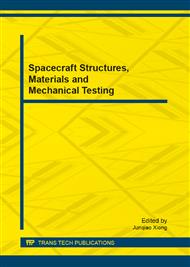p.31
p.41
p.47
p.53
p.63
p.71
p.79
p.85
p.91
An Engineering Model for the Impact Breakup of the Space Target
Abstract:
To the question of the breakup of the space target impacted by projectile, an engineering model is developed. The space target characteristic is analyzed, and the target equivalent model is established based on the thin plate. The average size model for the impact fragment of thin plate is established depending on strain rate, fragments are discrete according to Poisson statistic and fragment distribution model is figured out. The length and velocity degraded model is set up against projectile with the shape of cylindrical rod. The simulation case is analyzed and the result indicates that the related models are effective, flexible and have important reference value.
Info:
Periodical:
Pages:
63-68
Citation:
Online since:
February 2013
Authors:
Keywords:
Price:
Сopyright:
© 2013 Trans Tech Publications Ltd. All Rights Reserved
Share:
Citation:


